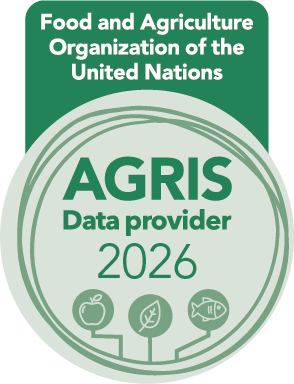Screening cultivated and wild genotypes of water melon Citrullus lanatus (Thumb) to identify resistance against Fusarium oxysporum f.sp. niveum race 2
DOI:
https://doi.org/10.24154/jhs.v20i1.2630Abstract
The present experiment was carried out to screen 341 Citrullus sp. accessions for identification of resistant genotypes against Fon race 2. The accessions were screened across two consecutive experiments conducted during the late-rainy season of 2017. Spore suspension of Fon race 2 was inoculated following the standard pipette method at 14-day seedling stage. An accession showing a mean survival of > 67% at 28 days post-inoculation (DPI) was categorized as resistant and the remaining accessions were categorized as susceptible. A total of 30 accessions were found resistant. Of them, eight accessions possessed a mean survival of > 90% at 28 DPI and were categorized as highly resistant. All these highly resistant accessions belong to C. lanatus with moderate fruit quality traits. Therefore, these genotypes could be used for watermelon improvement programs in the future that aim to incorporate resistance to Fon race 2 into the crop’s elite and commercial market segments without incurring linkage drag.
Downloads
References
Anonymous. (2023). *Area and production of horticultural crops for 2022-2023*. Ministry of Agriculture and Farmers' Welfare, New Delhi, India. (Accessed July 2, 2025).
Boyhan, G. E., Langston, D. M., Granberry, D. M., Lewis, P. M., & Linton, D. O. (2003). Resistance to Fusarium wilt and root-knot nematode in watermelon germplasm. *Cucurbit Genetics Cooperative Report, 26,* 18-25.
Branham, S., Wechter, W. P., Ling, K. S., Chanda, B., Messey, L., Zhao, G., Guner, N., Bello, M., Kabelka, E., Fei, Z., & Levi, A. (2019). QTL mapping of resistance to *Fusarium oxysporum* f. sp. *niveum* race 2 and Papaya ringspot virus in *Citrullus amarus*. *Theoretical and Applied Genetics, 133,* 677-687.
https://doi.org/10.1007/s00122-019-03500-3
Bruton, B. D., Fish, W. W., & Langston, D. B. (2008). First report of Fusarium wilt caused by *Fusarium oxysporum* f. sp. *niveum* race 2 in Georgia watermelons. *Plant Disease, 92,* 983.
https://doi.org/10.1094/PDIS-92-6-0983B
Campbell, C. L., & Madden, L. V. (1990). *Introduction to plant disease epidemiology*. Wiley.
Dane, F., Hawkins, L. K., Norton, J. D., Kwon, Y. S., & Om, Y. H. (1998). New resistance to Race 2 of *Fusarium oxysporum* f. sp. *niveum* in watermelon. *Cucurbit Genetics Cooperative Report, 21,* 37-39.
Egel, D. S., & Martyn, R. D. (2007). Fusarium wilt of watermelon and other cucurbits. *The Plant Health Instructor.*
https://doi.org/10.1094/PHI-I-2007-0122-01
Gunn, C. A., Weber, J. L., McGill, A. T., & Kruger, M. C. (2015). Increased intake of selected vegetables, herbs and fruit may reduce bone turnover in postmenopausal women. *Journal of Nutrition, 7,* 2499-2517.
https://doi.org/10.3390/nu7042499
Guo, S., Zhang, J., Sun, H., Salse, J., Lucas, W. J., Zhang, H., Zheng, Y., Mao, L., Ren, Y., Wang, Z., … Levi, A. (2013). The draft genome of watermelon (*Citrullus lanatus*) and resequencing of 20 diverse accessions. *Nature Genetics, 45,* 51-58.
https://doi.org/10.1038/ng.2470
Huh, Y. C., Om, Y. H., & Lee, J. M. (2002). Utilization of *Citrullus* germplasm with resistance to Fusarium wilt (*Fusarium oxysporum* f. sp. *niveum*) for watermelon rootstocks. *Acta Horticulturae, 588,* 127-132.
https://doi.org/10.17660/ActaHortic.2002.588.18
Kamdi, D. R., Mondhe, M. K., Jadesha, G., Kshirsagar, D. N., & Thakur, K. D. (2012). Efficacy of botanicals, bio-agents and fungicides against *Fusarium oxysporum* f. sp. *ciceri* in chickpea wilt sick plot. *Annals of Biological Research, 3*(11), 5390-5392.
King, S. R., Davis, A. R., Liu, W., & Levi, A. (2008). Grafting for disease resistance. *HortScience, 43,* 1673-1676.
https://doi.org/10.21273/HORTSCI.43.6.1673
Martyn, R. D., & Netzer, D. (1991). Resistance to races 0, 1, and 2 of Fusarium wilt of watermelon in *Citrullus* sp. PI296341-FR. *HortScience, 26,* 429-432.
https://doi.org/10.21273/HORTSCI.26.4.429
McGregor, C. E., & Waters, V. (2013). Pollen viability of F1 hybrids between watermelon cultivars and disease resistant, infra-specific crop wild relatives. *HortScience, 48*(12), 1428-1432.
https://doi.org/10.21273/HORTSCI.48.12.1428
Meru, G., & McGregor, C. E. (2016). Genotyping by sequencing for SNP discovery and genetic mapping of resistance to race 1 of *Fusarium oxysporum* in watermelon. *Scientia Horticulturae, 209,* 31-40.
https://doi.org/10.1016/j.scienta.2016.06.005
Pal, S., Rao, E. S., Reddy, D. C. L., & Varalakshmi, B. (2022). Association analysis in a germplasm panel of watermelon (*Citrullus lanatus* (Thunb.) Matsum. & Nakai) predominantly from India confirms a QTL conferring resistance to *Fusarium oxysporum* f. sp. *niveum* race 1. *The Journal of Horticultural Science and Biotechnology, 97*(1), 75-85.
https://doi.org/10.1080/14620316.2021.1980441
Pal, S., Rao, E. S., Thontadarya, R. N., Chandran, N. K., & Sriram, S. (2020). First report on the occurrence of race 1 and 2 of *Fusarium oxysporum* f. sp. *niveum* infecting watermelon in India. *Indian Phytopathology, 73,* 793-796.
https://doi.org/10.1007/s42360-020-00270-7
Paris, H. S. (2015). Origin and emergence of the sweet dessert watermelon *Citrullus lanatus*. *Annals of Botany, 116,* 133-148.
https://doi.org/10.1093/aob/mcv077
Wechter, W. P., Koushik, C., McMillan, M., & Levi, A. (2012). Identification of resistance to *Fusarium oxysporum* f. sp. *niveum* race 2 in *Citrullus lanatus* var. *citroides* plant introductions. *HortScience, 47*(3), 334-338.
https://doi.org/10.21273/HORTSCI.47.3.334
Wen, C., & Guo, K. (2017). *Fusarium oxysporum* strain XGKWJ3 internal transcribed spacer 1, partial sequence. NCBI Gene Bank ID: KY798172. Available at [https://www.ncbi.nlm.nih.gov](https://www.ncbi.nlm.nih.gov)
Zhou, X. G., Everts, K. L., & Bruton, B. D. (2010). Race 3, a new and highly virulent race of *Fusarium oxysporum* f. sp. *niveum* causing Fusarium wilt in watermelon. *Plant Disease, 94*(1), 92-98.
Downloads
Published
Data Availability Statement
NA
Issue
Section
License
Copyright (c) 2025 Saheb Pal, Sreenivasarao Eguru, R N Thontadarya, Sriram Subbaraman (Author)

This work is licensed under a Creative Commons Attribution-NonCommercial-ShareAlike 4.0 International License.
Authors retain copyright. Articles published are made available as open access articles, distributed under the terms of the Creative Commons Attribution-NonCommercial-ShareAlike 4.0 International License, which permits unrestricted non-commercial use, distribution, and reproduction in any medium, provided the original author and source are credited. 
This journal permits and encourages authors to share their submitted versions (preprints), accepted versions (postprints) and/or published versions (publisher versions) freely under the CC BY-NC-SA 4.0 license while providing bibliographic details that credit, if applicable.







 .
. 











